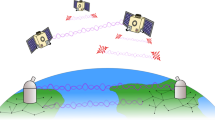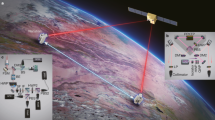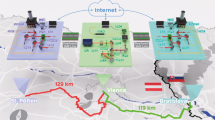Abstract
The quantum internet1 is predicted to be the next-generation information processing platform, promising secure communication2,3 and an exponential speed-up in distributed computation2,4. The distribution of single qubits over large distances via quantum teleportation5 is a key ingredient for realizing such a global platform. By using quantum teleportation, unknown quantum states can be transferred over arbitrary distances to a party whose location is unknown. Since the first experimental demonstrations of quantum teleportation of independent external qubits6, an internal qubit7 and squeezed states8, researchers have progressively extended the communication distance. Usually this occurs without active feed-forward of the classical Bell-state measurement result, which is an essential ingredient in future applications such as communication between quantum computers. The benchmark for a global quantum internet is quantum teleportation of independent qubits over a free-space link whose attenuation corresponds to the path between a satellite and a ground station. Here we report such an experiment, using active feed-forward in real time. The experiment uses two free-space optical links, quantum and classical, over 143 kilometres between the two Canary Islands of La Palma and Tenerife. To achieve this, we combine advanced techniques involving a frequency-uncorrelated polarization-entangled photon pair source, ultra-low-noise single-photon detectors and entanglement-assisted clock synchronization. The average teleported state fidelity is well beyond the classical limit9 of two-thirds. Furthermore, we confirm the quality of the quantum teleportation procedure without feed-forward by complete quantum process tomography. Our experiment verifies the maturity and applicability of such technologies in real-world scenarios, in particular for future satellite-based quantum teleportation.
This is a preview of subscription content, access via your institution
Access options
Subscribe to this journal
Receive 51 print issues and online access
$199.00 per year
only $3.90 per issue
Buy this article
- Purchase on Springer Link
- Instant access to full article PDF
Prices may be subject to local taxes which are calculated during checkout




Similar content being viewed by others
References
Kimble, H. J. The quantum internet. Nature 453, 1023–1030 (2008)
Nielsen, M. & Chuang, I. Quantum Computation and Quantum Information (Cambridge Univ. Press, 2000)
Gisin, N. & Thew, R. Quantum communication. Nature Photon. 1, 165–171 (2007)
Ladd, T. D. et al. Quantum computers. Nature 464, 45–53 (2010)
Bennett, C. H. et al. Teleporting an unknown quantum state via dual classical and Einstein-Podolsky-Rosen channels. Phys. Rev. Lett. 70, 1895–1899 (1993)
Bouwmeester, D. et al. Experimental quantum teleportation. Nature 390, 575–579 (1997)
Boschi, D., Branca, S., De Martini, F., Hardy, L. & Popescu, S. Experimental realization of teleporting an unknown pure quantum state via dual classical and Einstein-Podolsky-Rosen channels. Phys. Rev. Lett. 80, 1121–1125 (1998)
Furusawa, A. et al. Unconditional quantum teleportation. Science 282, 706–709 (1998)
Massar, S. & Popescu, S. Optimal extraction of information from finite quantum ensembles. Phys. Rev. Lett. 74, 1259–1263 (1995)
Hughes, R. J. et al. Free-space quantum key distribution in daylight. J. Mod. Opt. 47, 549–562 (2000)
Rarity, J. G., Tapster, P. R., Gorman P. M & Knight, P. Ground to satellite secure key exchange using quantum cryptography. N. J. Phys. 4, 82 (2002)
Aspelmeyer, M. et al. Long-distance free-space distribution of quantum entanglement. Science 301, 621–623 (2003)
Marcikic, I., Lamas-Linares, A. & Kurtsiefer, C. Free-space quantum key distribution with entangled photons. Appl. Phys. Lett. 89, 101122 (2006)
Ursin, R. et al. Entanglement-based quantum communication over 144 km. Nature Phys. 3, 481–486 (2007)
Villoresi, P. et al. Experimental verification of the feasibility of a quantum channel between space and Earth. N. J. Phys. 10, 033038 (2008)
Fedrizzi, A. et al. High-fidelity transmission of entanglement over a high-loss free-space channel. Nature Phys. 5, 389–392 (2009)
Scheidl, T. et al. Feasibility of 300 km quantum key distribution with entangled states. N. J. Phys. 11, 085002 (2009)
Jin, X.-M. et al. Experimental free-space quantum teleportation. Nature Photon. 4, 376–381 (2010)
Scheidl, T. et al. Violation of local realism with freedom of choice. Proc. Natl Acad. Sci. USA 107, 19708–19713 (2010)
Marcikic, I., de Riedmatten, H., Tittel, W., Zbinden, H. & Gisin, N. Long-distance teleportation of qubits at telecommunication wavelengths. Nature 421, 509–513 (2003)
Ursin, R. et al. Quantum teleportation across the Danube. Nature 430, 849 (2004)
Briegel, H.-J., Dür, W., Cirac, J. I. & Zoller, P. Quantum repeaters: the role of imperfect local operations in quantum communication. Phys. Rev. Lett. 81, 5932–5935 (1998)
Einstein, A., Podolsky, B. & Rosen, N. Can quantum-mechanical description of physical reality be considered complete? Phys. Rev. 47, 777–780 (1935)
Kwiat, P. G. et al. New high-intensity source of polarization-entangled photon pairs. Phys. Rev. Lett. 75, 4337–4341 (1995)
Calsamiglia, J. & Lütkenhaus, N. Maximum efficiency of a linear-optical Bell-state analyzer. Appl. Phys. B 72, 67–71 (2001)
Kim, Y.-H., Kulik, S. P., Chekhova, M. V., Grice, W. P. & Shih, Y. Experimental entanglement concentration and universal Bell-state synthesizer. Phys. Rev. A 67, 010301(R) (2003)
Poh, H. S., Lim, J., Marcikic, I., Lamas-Linares, A. & Kurtsiefer, C. Eliminating spectral distinguishability in ultrafast spontaneous parametric down-conversion. Phys. Rev. A 80, 043815 (2009)
Yao, X.-C. et al. Observation of eight-photon entanglement. Nature Photon. 6, 225–228 (2012)
Kim, Y.-S., Jeong, Y.-C., Sauge, S., Makarov, V. & Kim, Y.-H. Ultra-low noise single-photon detector based on Si avalanche photodiode. Rev. Sci. Instrum. 82, 093110 (2011)
White, A. G., James, D. F. V., Eberhard, P. H. & Kwiat, P. G. Nonmaximally entangled states: production, characterization, and utilization. Phys. Rev. Lett. 83, 3103–3107 (1999)
Żukowski, M., Zeilinger, A., Horne, M. A. & Ekert, A. K. “Event-ready-detectors” Bell experiment via entanglement swapping. Phys. Rev. Lett. 71, 4287–4290 (1993)
Aspelmeyer, M., Jennewein, T., Pfennigbauer, M., Leeb, W. R. & Zeilinger, A. Long-distance quantum communication with entangled photons using satellites. IEEE J. Sel. Top. Quantum Electron. 9, 1541–1551 (2003)
Yin, J. et al. Quantum teleportation and entanglement distribution over 100-kilometre free-space channels. Nature 488, 185–188 (2012)
Acknowledgements
We thank the staff of IAC: F. Sanchez-Martinez, A. Alonso, C. Warden, M. Serra and J. Carlos; and the staff of ING: M. Balcells, C. Benn, J. Rey, O. Vaduvescu, A. Chopping, D. González, S. Rodríguez, M. Abreu, L. González; J. Kuusela, E. Wille and Z. Sodnik; and J. Perdigues of the OGS and ESA. X.-S.M., T.J., R.U. and A.Z. thank S. Ramelow for discussions, P. Kolenderski for discussions on the SPDC source with the Bell-state synthesizer, S. Zotter for help during the early stages of the experiment, and R. Steinacker for meteorological advice. J.K. was supported by the EU project MALICIA. E.A. and V.M. thank C. Kurtsiefer and Y.-S. Kim for detector electronics design, J. Skaar for support, and the Research Council of Norway (grant No. 180439/V30) and Industry Canada for support. This work was made possible by grants from the European Space Agency (contract 4000104180/11/NL/AF), the Austrian Science Foundation (FWF) under projects SFB F4008 and CoQuS, and the FFG for the QTS project (no. 828316) within the ASAP 7 program. We also acknowledge support by the European Commission, grant Q-ESSENCE (no. 248095) and the John Templeton Foundation.
Author information
Authors and Affiliations
Contributions
X.-S.M. conceived the research, designed and carried out the experiment, and analysed data. T.H., T.S. and D.W. carried out the experiment and analysed data. S.K., W.N., B.W. and A.M. provided experimental assistance during the early stage of the experiment. J.K. provided the theoretical analysis and analysed data. E.A. and V.M. developed the ultra-low-noise detectors. T.J. provided experimental and conceptual assistance, and conceived and developed the coincidence analysis code. R.U. conceived the research, planned and carried out the experiment and analysed data. A.Z. defined the scientific goals, conceived the research, designed the experiment and supervised the project. X.-S.M., T.H., T.S., J.K., R.U. and A.Z. wrote the manuscript with assistance from all other co-authors.
Corresponding authors
Ethics declarations
Competing interests
The authors declare no competing financial interests.
Supplementary information
Supplementary Information
This file contains Supplementary Text and Data and additional references. (PDF 108 kb)
Rights and permissions
About this article
Cite this article
Ma, XS., Herbst, T., Scheidl, T. et al. Quantum teleportation over 143 kilometres using active feed-forward. Nature 489, 269–273 (2012). https://doi.org/10.1038/nature11472
Received:
Accepted:
Published:
Issue Date:
DOI: https://doi.org/10.1038/nature11472
This article is cited by
-
Demonstration of controlled high-dimensional quantum teleportation
Science China Physics, Mechanics & Astronomy (2024)
-
Continuous variable quantum teleportation and remote state preparation between two space-separated local networks
Science China Information Sciences (2024)
-
Cyclic Quantum Teleportation with Multi-Level of Control
International Journal of Theoretical Physics (2024)
-
Hertz-rate metropolitan quantum teleportation
Light: Science & Applications (2023)
-
Progress in quantum teleportation
Nature Reviews Physics (2023)
Comments
By submitting a comment you agree to abide by our Terms and Community Guidelines. If you find something abusive or that does not comply with our terms or guidelines please flag it as inappropriate.



